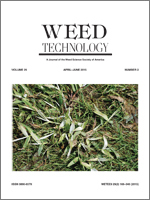Growers have observed lack of control of ragweed parthenium with glyphosate at 0.84 kg ae ha−1 used for weed control in noncrop areas and fallow fields in the Everglades Agricultural Area (EAA) of South Florida. Therefore, studies were conducted to (1) confirm and characterize the level of glyphosate resistance in ragweed parthenium from the EAA, (2) determine if reduced absorption or translocation is the mechanism of resistance of ragweed parthenium to glyphosate, and (3) evaluate the efficacy of POST herbicides commonly used in cultivated and noncrop areas for broadleaf weed control on flowering ragweed parthenium at the full and half labeled rate. A dose-response bioassay was used to determine the response of the rosette ragweed parthenium biotype from the EAA (resistant) and a susceptible biotype from Stoneville, MS, to glyphosate. The bioassay showed that the resistant biotype was 40- to 43-fold less sensitive to glyphosate when compared to the susceptible biotype. There was no significant difference in glyphosate absorption or translocation from the treated leaf to the rest of the plant 168 h after treatment between resistant and susceptible biotypes. This shows that absorption or translocation is not a mechanism of glyphosate resistance by ragweed parthenium. Saflufenacil dimethenamid-P and hexazinone provided rapid and complete control of flowering ragweed parthenium 3 wk after treatment (WAT). Aminocyclopyrachlor chlorsulfuron and aminopyralid at the full and the half label rates provided 100% control of ragweed parthenium by 9 WAT. Clopyralid, 2,4-D amine, and glufosinate at the full label rate provided 89 to 98% control of ragweed parthenium 9 WAT. Control of ragweed parthenium 9 WAT was < 75% with flumioxazin, fomesafen, glyphosate, imazapic, imazethapyr, mesotrione, oxyfluorfen, and paraquat, irrespective of use rate.
Nomenclature: Aminocyclopyrachlor; aminopyralid; chlorsulfuron; clopyralid; 2,4-D amine; dimethenamid-P; flumioxazin; fomesafen; glufosinate; glyphosate; hexazinone; imazapic; imazethapyr; mesotrione; oxyfluorfen; paraquat; saflufenacil; ragweed parthenium, Parthenium hysterophorus L.
Productores han observado la falta de control de Parthenium hysterophorus con glyphosate a 0.84 kg ae ha−1 usado para el control de malezas en áreas sin cultivos y en campos en barbecho en el Área Agrícola de los Everglades (EAA) en el sur de Florida. Por esta razón, se realizaron estudios para (1) confirmar y caracterizar el nivel de resistencia a glyphosate en P. hysterophorus en el EAA, (2) determinar si la reducción en la absorción o la translocación es el mecanismo de resistencia a glyphosate en P. hysterophorus, y (3) evaluar la eficacia de herbicidas POST comunes en áreas cultivadas y sin cultivos para el control de malezas de hoja ancha sobre P. hysterophorus en floración usando la mitad de la dosis de etiqueta y la dosis completa. Se realizó un bioensayo de respuesta a dosis para determinar la respuesta a glyphosate del biotipo de P. hysterophorus proveniente de EAA (resistente) y un biotipo susceptible proveniente de Stoneville, Mississippi, ambos en estado de roseta. El bioensayo mostró que el biotipo resistente fue 40 a 43 veces menos sensible a glyphosate cuando se comparó con el biotipo susceptible. No hubo diferencias significativas entre el biotipo resistente y el susceptible en la absorción o translocación de glyphosate desde la hoja tratada al resto de la planta, 168 h después del tratamiento. Esto demuestra que la absorción o translocación no es el mecanismo de resistencia de P. hysterophorus. Saflufenacil dimeth





